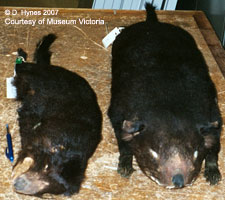Mainland Tasmanian devils
Photo: Museum of Victoria / Debbie Hynes, Copyright 2007 Debbie Hynes.
Text may be reproduced. Photos may not be reproduced without written permission.
WLMD is proud to be part of the search for Tasmanian devils on mainland Australia.
Most people aren't aware that at least 5 Tasmanian devils have been collected in Victoria between 1903 and 1991.
Debbie Hynes of thylacoleo.com and I teamed up in 2007 for the search and launched the website at mainlanddevils.com.au to report our progress.
From our first media release there:
Victorian student researcher Debbie Hynes and Sydney amateur naturalist Chris Rehberg have teamed up in the search for wild Tasmanian Devils living in Victoria.
Museum Victoria recently invited Debbie and her colleague Mike Cleeland to view two of the five devil specimens in its collection. The larger of these was a male collected in 1971 at Dereel and the second a female from Tooborac, collected in 1912.
"We're excited to be able to view these specimens first hand," says Hynes. "I think many people don't realise that five Tasmanian devils have been collected from the wild in Victoria, over a period of nearly ninety years. The most recent were in 1991."
Opinions are divided on the origin of these mainland devils. "I have heard that DNA research has been done on at least some of these specimens which shows they are genetically similar to devils from Tasmania. This means they might be recent reintroductions from that state, but we still have to track down that research and read it first hand" says Rehberg.
Although many scientists accept that the devil became extinct on the mainland about 500 years ago there is still a small chance that these specimens descended from mainland stock. Rehberg recently put forward some questions about the significance of finding a mainland population of Tasmanian devils: "To the best of my knowledge, there is still no effective test to detect devil facial tumour disease (DFTD) - a condition which has wiped out up to eighty percent of devils in Tasmania by some estimates. The species is facing the serious threat of extinction in the wild at least."
"How do we know that DFTD was not involved in practically wiping out the mainland stock 500 years ago with just a few pockets of individuals remaining to this day? If this is true, then these are the survivors of DFTD and could be critical to saving the species. Even if this isn’t the case, their existence would still be very significant. The first step is finding them," and finding animals that just aren't supposed to be there, is Hynes' specialty.
The eighteen year old has spent the past two years conducting a Parks Victoria backed biodiversity study in Victoria's East Gippsland. It began with her major discovery of populations of mountain brush-tail possums (known as bobucks) in The Gurdies Nature Reserve on the shores of Westernport. The discovery was significant because these native animals are an alpine species that are adapted to life in the cold climate above the snow line but were found to inhabit atypical coastal swamp environments. "We don’t know yet if their presence along the Gippsland coast is a recent phenomenon to do with climate change" says Hynes.
Using infrared remote cameras she developed herself, Hynes has been able to plot the distribution of bobucks in Gippsland and her results are to be published in The Victorian Naturalist scientific journal. With this survey almost complete, she looks forward to deploying her technology in strategic locations to begin a search for mainland "Tasmanian" Devils.
The team encourages anyone who believes they might have information relating to mainland devils to contact them - report Mainland Tasmanian devil information now.
